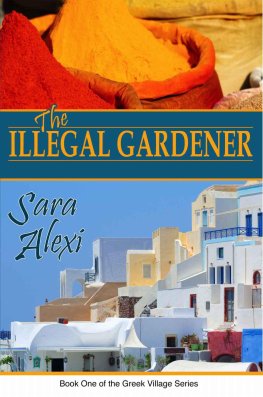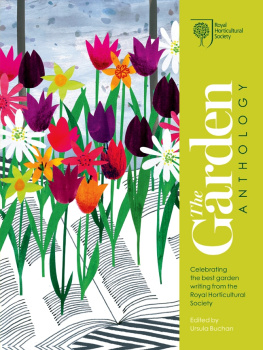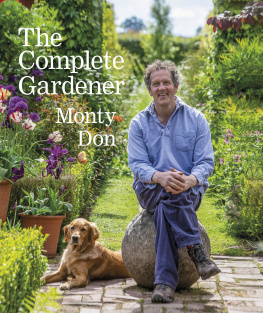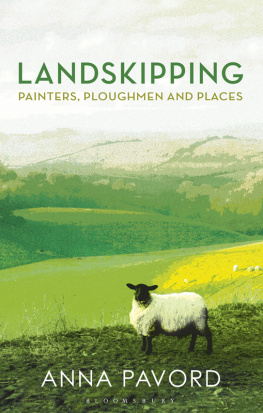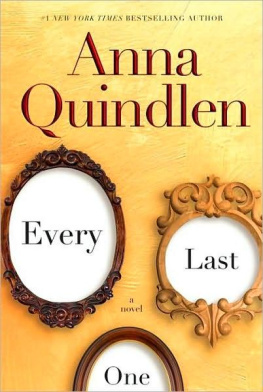Anna Pavord - The Curious Gardener
Here you can read online Anna Pavord - The Curious Gardener full text of the book (entire story) in english for free. Download pdf and epub, get meaning, cover and reviews about this ebook. year: 2011, publisher: Bloomsbury USA, genre: Detective and thriller. Description of the work, (preface) as well as reviews are available. Best literature library LitArk.com created for fans of good reading and offers a wide selection of genres:
Romance novel
Science fiction
Adventure
Detective
Science
History
Home and family
Prose
Art
Politics
Computer
Non-fiction
Religion
Business
Children
Humor
Choose a favorite category and find really read worthwhile books. Enjoy immersion in the world of imagination, feel the emotions of the characters or learn something new for yourself, make an fascinating discovery.
- Book:The Curious Gardener
- Author:
- Publisher:Bloomsbury USA
- Genre:
- Year:2011
- Rating:3 / 5
- Favourites:Add to favourites
- Your mark:
- 60
- 1
- 2
- 3
- 4
- 5
The Curious Gardener: summary, description and annotation
We offer to read an annotation, description, summary or preface (depends on what the author of the book "The Curious Gardener" wrote himself). If you haven't found the necessary information about the book — write in the comments, we will try to find it.
The Curious Gardener — read online for free the complete book (whole text) full work
Below is the text of the book, divided by pages. System saving the place of the last page read, allows you to conveniently read the book "The Curious Gardener" online for free, without having to search again every time where you left off. Put a bookmark, and you can go to the page where you finished reading at any time.
Font size:
Interval:
Bookmark:
What honours are there left in life since I scooped the big one a first prize for my potatoes at the Melplash Agricultural Show? I fear I may have peaked too early, for since that seminal summer, Ive never again grown potatoes perfect enough to set before the critical gaze of the Melplash judges. The winning spud was Catriona, a long, oval second early variety with purple eyes marked on a smooth white skin.
It is an old potato, known since 1920, and a useful one in our neck of the woods because the haulm dies down early and so does not get blighted as readily as other varieties. The ironic thing about those prize-winning Catriona potatoes is that they were what my mother called moochers, potatoes that got left behind in the ground when I was digging the main crop. They started themselves into growth in the spring, but were never earthed up. Instead, they got covered rather thickly with grass cuttings.
This kept the ground underneath moist during hot weather. It also made lifting incredibly easy. I scarcely had to dig, merely scraped away the 6-inch (15-centimetre) layer of grass. There were the potatoes, sitting like a nest of goose eggs, clean and gleaming. Having by accident discovered this labour-saving way of growing, Ive tried it several times since. It works well on a plot in our kitchen garden that is mulched thickly with leaves every winter, and never dug.
Why bother, some gardeners ask? Potatoes are so cheap to buy. True, but the selection in supermarkets is pathetic, compared with the 118 varieties of seed potatoes offered, for instance, by the Scottish firm of Websters. And if you like cooking, you need different kinds of potato to do different things. For baking, you might turn to Epicure, Osprey or Romano. For roasting youd perhaps choose Accent, Edzell Blue or Dunbar Standard. For boiling, you need Marfona, Argos or Maris Piper. For mashing, I like Winston, Desiree and Sante. For salads you have to have waxy potatoes such as Pomfine, Belle de Fontenay and Pink Fir Apple. For chips, you might reach for Swift, Cara or Pentland Dell.
Once you are committed to the idea of growing your own, you face another series of choices to find the clutch of potatoes most likely to succeed on your kind of ground. If its a windy or exposed plot, try the first early Colmo, with low, spreading foliage. The new second early Bydand will also survive howling gales. Where slugs are particularly ghastly, choose Vanessa, the old variety British Queen (1894), Kestrel or Pentland Squire. On dry soils, Arran Pilot, Rocket, Estima and Pentland Dell all survive and crop in drought-ridden summers.
If you suffer from retrostalgia, an overwhelming conviction that nothing now is as good as it used to be, send to Edwin Tucker for a selection of potato plants, micropropagated from varieties now more than a hundred years old. These exist in such small quantities that you cant buy them as tubers. Instead Tuckers send out ready-grown plants in late May and early June. They have twenty-two of these rare varieties on offer, including Shetland Black, known since 1900, Skerry Blue from 1846 and Champion, reputed to be the best-flavoured potato ever raised. Its been known in Arbroath since 1862.
As well as tasting better than you had ever imagined a potato could taste, many old varieties have blessedly strong constitutions. In the slap-happy, spray-happy post-war years, this was not valued as much as it perhaps is now, when the effects of eating poisons for lunch are beginning to be more clearly understood. Edzell Blue is immune to wart disease. Dunbar Rover is resistant to blight.
Even their best friends would not call potatoes a decorative addition to the kitchen garden, though Red Duke of York took my fancy this last summer, with its dark purplish foliage and purple flowers. Its a first early, producing red potatoes that bake well and can also double up as salad potatoes.
Early potatoes mature in about fourteen to sixteen weeks, so from a March planting, you might be eating the first new potatoes by the end of June. Before you plant, you have to chit the tubers by laying them out in trays to sprout. Planting time depends on the weather. If you plant too early, sudden frost may cut down the nesh, green foliage. Commercial growers use spun polypropylene covers over their crops to protect them against this. In Lincolnshire and Bedfordshire, the flat fields look like lakes, covered entirely with a shimmering web. The system works for gardeners too.
You can grow early potatoes in containers with reasonable success, but the bigger the container, the greater the success. Crops from early potatoes are, anyway, lighter than the load you might expect from a maincrop potato, so it is best to use the fast-maturing, lighter-cropping earlies if you want to grow in a pot (or a dustbin they work very well). Extra early types such as Dunluce or Rocket are best for this.
In the unusually quiet days that lay between Christmas and the New Year, I read happily through lists of old potatoes and sorted out an order. I love mail order, because by the time a parcel arrives, Ive usually forgetten what Ive sent for. Amongst others I put in for Red Duke of York, bred around 1940, Dunbar Rover (sounds like a football team), which is a few years older and Edzell Blue, grown in Edzell, Angus a year after the First World War broke out. What supermarket can produce such delights as these? And what restaurant can provide a treat as good as a fluffy pile of Edzell Blue mash, whipped up with good farm butter, a twist of pepper and a dusting of freshly grated nutmeg? Even dear Jamie would be pushed to match that.
Having completed the order, I announced the fact brightly to daughter no. 2. And? she replied after a pause just long enough to wither entirely any hope on my part that potatoes might be a subject fit for family conversation. But in the solitude of the hell hole that is my potting corner, I continue to be quietly excited.
The Independent invited me to be its gardening correspondent when the paper was first set up in 1986 and I have been writing a weekly column for them ever since. I am grateful to the editor for allowing me to reprint some of these columns in The Curious Gardener. I am also delighted that Howard Phipps, whose work I have admired for years, has allowed us to use a selection of his fine wood engravings to introduce each section. The book crystallised over lunch with Caradoc King, my agent at A. P. Watt. He paid. Thank you, Caradoc. At Bloomsbury, Bill Swainson has been an exemplary editor. I am indebted to him and also to Emily Sweet, the managing editor, and Sarah Greeno, who designed the jacket. My final thank you is to Penny Edwards, who once again has produced a very elegant book.
When I met David Goff Eveleigh, he had just come back from a Mad Hatters tea party in Shropshire. Ah! I said carefully. And what do you do the rest of the time?
Alchemy, he replied, looking me straight in the eyes. Clowning about. Being Lord of Misrule. I create and control chaos. Its a wonderful thing you know, chaos. The lord of chaos is master of all. I deal in fire and water. Fire and air.
Ah, I said again.
Now Im into earth, he added helpfully. Im earthed at last. I was once before. I had a smallholding. A big organic patch. Grew veg. Very pretty. I had chickens. A performing goose. A cockerel called Sir Henry Oake who used to play the drums. And the piano.
Just then I was very tempted to write an entire article on training cockerels to hit the skins. Suddenly, it seemed so boring being a gardening writer. A new life as circus correspondent glittered before me. But it was not to be. Mr Eveleigh remembered that Id come to see a maze. Maze-wards we went, tramping through the parkland of an old estate called Penpont, just west of Brecon.
Penpont had recently been taken over by Gavin and Davina Hogg. The whole maze thing started because we had an incredible crop of beech mast, explained Gavin Hogg, an arboriculturist by training. All over the woods these little beech trees started springing up. We wanted to find a use for the trees. And we wanted to do something for the millennium. First we thought of an avenue in the park, but that wouldnt have used many of the beech. Then we got into mazes.
Next pageFont size:
Interval:
Bookmark:
Similar books «The Curious Gardener»
Look at similar books to The Curious Gardener. We have selected literature similar in name and meaning in the hope of providing readers with more options to find new, interesting, not yet read works.
Discussion, reviews of the book The Curious Gardener and just readers' own opinions. Leave your comments, write what you think about the work, its meaning or the main characters. Specify what exactly you liked and what you didn't like, and why you think so.


